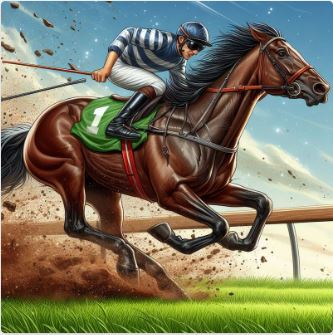PUREFORM
Australian Horse Racing
The Edge
We all want to be competitive in everything we do. And no more so that with punting on horse racing.
Success in punting on horses, in fact most things reduces down to an information war - the people with the best information make the smart moves.
Books have been and still are the best source of general information, and this applies at least as much in the art of racehorse selection and staking as in any other field.
Author Paul Segar has produced textbooks which cover all aspects of punting. The books alone stand as a complete reference but also provide 'food for thought'. You can develop / improve your own ideas as well as learn some new techniques.
Each book is written in plain English with plenty of practical examples in each chapter. Browse the contents of each book or email for further information, if required.
Improve your punting knowledge today - buy one or all of these
books.
Read the books but want more? It's time to do a course.
The Pureform Introduction Course uses a computer program to show you how and when to bet and how to do it successfully. Check out the details
The Benchmark Handicapper Course continues from the Introduction Course and gives you further weapons to apply when making quality value selections. More...
The Introduction to Dutch Betting using the Ratings Calculator Course gives you an introduction to betting using the Ratings Calculator computer software. More...
Buy all three books now:
$70 posted
Contents
Introduction
Target Betting
Markets
Savers
Overs
The Usual Punter
Unders
Where to Now?
5. Overs
The next logical section of the discussion is overs punting.

There are two markets. The TAB or bookmaker market and your market. Call your market the calculated market or calculated odds.
An overs bet is one where the odds available are longer than the calculated odds and was shown in the previous example.
In this example both horses A and D had available odds better than the calculated market.
| Horse | Odds | Available | Wager | Return | Profit |
|---|---|---|---|---|---|
| A | $3 | $5 | $33 | $165 | +$97 |
| D | $12 | $16 | $8 | $128 | +$60 |
| Outlay: | $41 |
Clearly if either of the two overs won then a nice profit would be returned.
The outlay on the race taking only the overs would be $41 compared to $68 if saving on the favourite (and $81 if backing all the runners).
One of the real strengths of overs punting is that the amount returned from a successful bet is quite often higher than the target amount.
In the case of horse A, the profit was almost as much as the target figure.
Not every race will be a winner and this is another advantage of overs punting. Total outlay when overs punting is often much lower with potential healthy returns only. Any underpriced runners are ignored. (Another useful approach is to back the overs for the place.)
Overs punting does not work in every race. Take the 2012 Newmarket Handicap as a great example of unsuccessfully doing markets when Hay List finished too strong on the middle of the track.
In a field of 22 runners there was no chance to mark Hay List at starting price of $3.80 let alone shorter than this to produce an over.
Result? Either other runners would have been supposted and lost or no bet.
Basically markets are great in races where there are no champion runners.
Another advantage when using a market and overs punting is the amount bet is calculated exactly and not “Willy Nilly” according to the current situation. This effectively reduces losses without limiting potential profit.

6. The Usual Punter

The usual punter will have some idea of a horse’s price but in many cases will change their opinion on seeing the real prices.
The normal thing is something like, ’ I think this horse is about a $5 chance.’
Sure enough the prices are put up and only $2.50 is available.
The average punter and we have all been there, adjusts the price opinion and instead of having $20 for the win at $5, bets $25 or more at $2.50.
Instead of betting the right amount at $5 (which would be zero as the bet is a big under) more is wagered at a lower price, betting the under to win.
The horse doesn't have a better chance because its price is shorter. Yes, there may be stable money, yes, the jockey is in-form, the trainer may have more than half the runners, the list goes on, but all these factors should be considered when selecting $5 as the price for that runner.
The two results:
The horse at the shorter price romps in by 5 lengths and you think to hell with prices! Remember Hay List.
Or
The horse is beaten out of sight as a short priced favorite
Or any number of possibilities in between.
At the other extreme, our favorite punter thinks the horse is a $5 chance but then is shocked to see its price at $12.
Clearly, thinks the punter (and here we emphasise the word clearly as nothing in horse racing is clear before the race), there must be something wrong with my thinking and as a result bets less or even changes to another selection.
Again the price shown on a runner does not indicate its real chance and only after the race is the real price known.
In this instance the price is double the expected and so perhaps a smaller wager may be in order. As in all horse racing, it depends on so many other factors…
Remember betting markets is about long term punting, not just one race or one race meeting.
It is about betting consistently at every meeting of interest and maintaining consistent prices and then betting according to those prices.
Long term success can be achieved by using this level of structure in pricing and betting on horse racing. Alternatively, losses can be reduced using a consistent method.
7. Unders

Another approach to try with well constructed markets is to lay the unders on Betfair.
An underlay or under is when the available price on a runner is less than that needed by your market. The bet is taken for the horse to not win, that is lay that runner for the win.
The same can be applied in place betting but in that case the horse has to finish unplaced which can become complicated.
There are many to win lay betting but one useful method is to lay the runners that are double unders or worse on your market compared to the available Betfair odds.
Looking at the market from earlier:
| Horse | Price | Available Odds | Type |
|---|---|---|---|
| A | $3 | $5 | Over |
| B | $5 | $2.5 | Under |
| C | $7 | $4 | Under |
| D | $12 | $16 | Over |
| E | $15 | $7 | Under |
Clearly B, C and E are unders as before. Double unders would be basically laying horses less than half the market odds so horse B and E are double unders with C just missing out but for this exercise will be included to highlight the method.
For this method, there are two options, lay the horses using your odds or using the Betfair Odds:
| Laying Horses using Your Odds | ||||
| Horse | Price | Available Odds | Wager | Potential Loss |
|---|---|---|---|---|
| B | $5 | $2.5 | $20 | $9 |
| C | $7 | $4 | $14 | $15 |
| E | $15 | $7 | $7 | $15 |
So a potential collect of $41 if all 3 horses do NOT win ($20+$14+$7). If one horse wins, the amount lost will vary (as shown in the table).
| Laying Horses using the Available Odds | ||||
| Horse | Price | Available Odds | Wager | Potential Loss |
|---|---|---|---|---|
| B | $5 | $2.5 | $40 | $21 |
| C | $7 | $4 | $25 | $21 |
| E | $15 | $7 | $14 | $21 |
In this case you are laying the horse as in the previous table but using the Betfair available odds.
So a potential collect of $79 if all 3 horses do NOT win.
The amount lost will be $21 regardless of which horse wins. In this case you are laying the horse to lose $100 but the loss will not be $100 or effectively the opposite of betting to collect using the available odds (in which the win is also not $100).
Laying horses is a little more confusing than betting to win but can be just as profitable given some useful markets.
If you are interested in Target Betting you can try the Ratings Calculator for a month for $55. Email Pureform for more details.

Horse racing as a sport for entertainment and potential profit is a great way to spend an afternoon or more battling against yourself and the four legged competitors and for most people a modest loss is the best to be expected.
At the same time, you may as well be as competitive as you can be and this is where the strength of prices and target betting is important. Yes you will miss Hay List as an over but at the same time will avoid lots of short priced runners which are underpriced.
Producing a market or having a strong price opinion about a runner and then supporting that runner when well-priced will ultimately produce more profit and reduce losses.
Horses can be both backed to win and laid using a well prepared market.

8. Where to Now?
The first thing is to create some markets and practice betting.
Check out your success on a trial basis and assess if this type of betting is for you.
Need to convert some ratings into a market, try the Pureform Ratings Calculator




